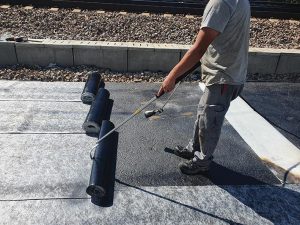The efficiency of bituminous waterproofing makes it popular in the building industry. To facilitate and accelerate its installation, as well as to spare the back of the worker in charge of the construction site, Express has designed an ergonomic, practical, and lightweight sealing rod. Find out which tool you need if you need to work with rolls of bitumen.
The advantages of bituminous waterproofing
Bitumen is a very popular material because of its ability to waterproof and insulate roofs. It is used for both new constructions and renovation work. Bituminous waterproofing is effective, but it is also appreciated because the material, once heated, is malleable and adapts to all configurations.
Bitumen protects the roof of a house from rain, snow, dust, wind, etc. It effectively insulates it from cold, heat, dirt, and moisture.
The limits of bituminous waterproofing are imposed by the slope of the roof, which must not exceed 20%.
What does the bitumen look like that is used for bituminous waterproofing?
The bitumen is packaged in the form of a roll. A non-woven polyester frame is used as a base to form the weft. It is coated with bitumen and then rolled up.
Once the bitumen is laid, it can be covered with bituminous shingles. For flat roofs to which residents have access, the ground is then covered with a top layer of various materials to make it aesthetic and comfortable: gravel, concrete slabs, stone slabs, resin, wood slabs, etc.
Laying bituminous waterproofing
To lay bituminous waterproofing, the worker places the roller on the ground, allowing for an overlap of about ten centimetres between the different strips. The use of the torch softens the bitumen and unwinds the roll to progress over the surface of the roof.
Once the installation of the entire surface is complete, you can make the finishing touches by checking the joints and sealing the edges and corners of the roof with bitumen. It is also important to check that no blisters have formed. If necessary, they must be incised with a cutter in order to release the air pocket. The incision site must then be sealed with a specific adhesive product.
The Express sealing rod to facilitate the installation of bituminous waterproofing

The sealing rod developed by Express eliminates the need for the installer to bend down. He holds it in one hand, his torch in the other, and unwinds the roll by pulling on the rod. His progress is thus more fluid, which saves him working time.
The handle is made of aluminium for the fixed version and stainless steel for the telescopic version. The fixed rod weighs only 510 grams for 1.30 metres, the telescopic pole is even lighter, weighing 450 grams, for a length of between 85 and 135 centimetres.
The hook at the end of the rod is made of aluminium. It is rounded so that there is no risk of piercing the bitumen.
Practical, easy, and light, the waterproofing rod ensures better working conditions for the worker, as well as greater efficiency.
